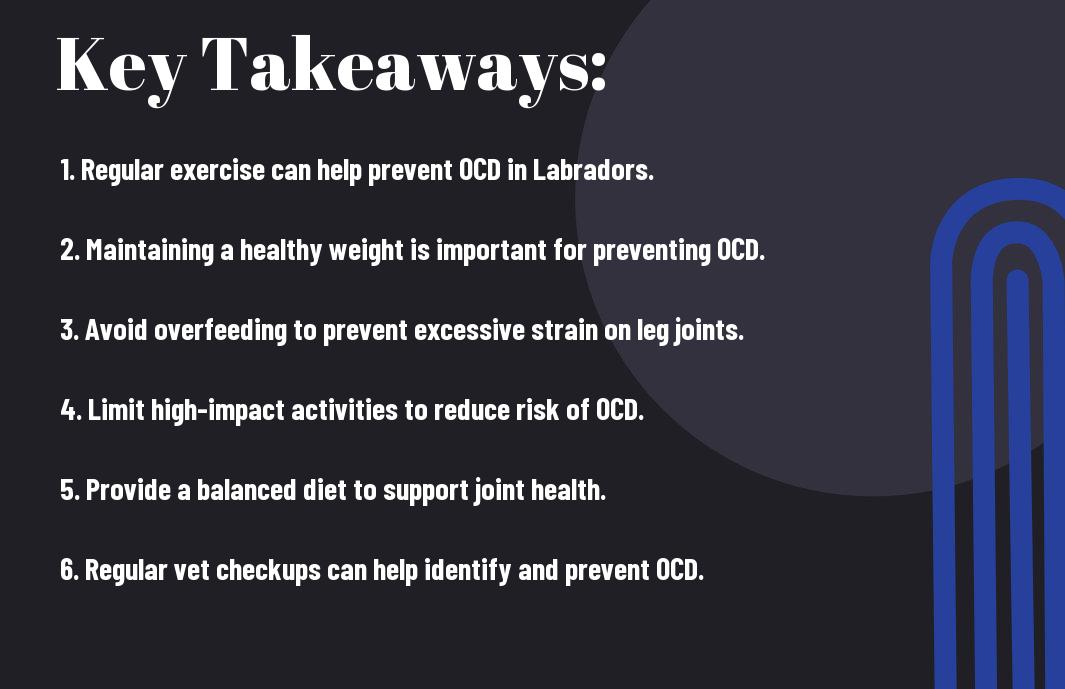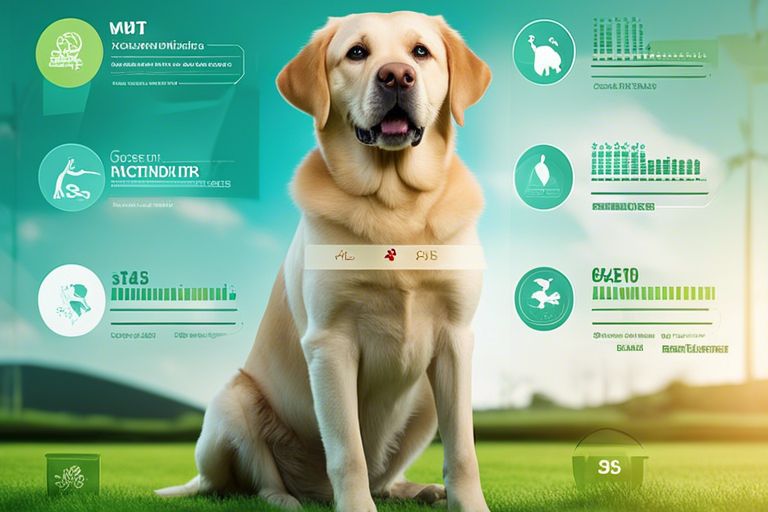Are you worried about osteochondritis dissecans in your Labrador Retriever?This condition can be a serious and painful problem for your beloved pet. However, there are steps you can take to minimize the risk of your Labrador developing this condition. In this blog post, we will discuss the causes and symptoms of osteochondritis dissecans, as well as provide preventative measures you can implement to keep your furry friend healthy and active.
Table of Contents
Key Takeaways:
- Proper Nutrition: Providing a balanced diet and maintaining a healthy weight can help prevent leg osteochondritis dissecans in Labrador Retrievers.
- Exercise Management: Avoid overexerting young Labrador Retrievers with rigorous exercise to reduce the risk of osteochondritis dissecans.
- Regular Veterinary Check-ups: Regular vet check-ups can help detect any signs of osteochondritis dissecans early, allowing for timely treatment and prevention.
- Avoiding Trauma: Preventing trauma to the legs through careful monitoring and supervision can reduce the likelihood of developing leg osteochondritis dissecans.
- Genetic Screening: Screening for genetic predisposition to osteochondritis dissecans in Labrador Retrievers can help prevent the condition through selective breeding and responsible ownership.
Understanding Osteochondritis Dissecans
Assuming you are a Labrador Retriever owner, it is important to understand the condition known as osteochondritis dissecans (OCD). This is a developmental orthopedic disease that affects the joints, particularly in large and giant breed dogs like Labradors. The condition occurs when the normal process of bone development is disrupted, leading to abnormal cartilage growth and potential joint dysfunction. It is crucial to familiarize yourself with this condition to better care for your Labrador’s joint health and overall well-being.
The Pathophysiology of OCD
OCD is characterized by abnormal cartilage growth and development within the affected joint. This occurs due to a disruption in the normal process of endochondral ossification, leading to the formation of abnormal cartilage and subchondral bone. Over time, this can lead to the detachment of the abnormal cartilage and the formation of loose fragments within the joint.
Symptoms and Diagnosis in Labrador Retrievers
In Labrador Retrievers, OCD commonly affects the shoulder, elbow, hock, and stifle joints. The condition may manifest with symptoms such as lameness, joint swelling, stiffness, pain, and reluctance to engage in physical activity. If you notice any of these symptoms in your Labrador, it is crucial to seek veterinary evaluation for an accurate diagnosis. Your veterinarian may perform a physical examination, imaging studies such as X-rays or MRI, and possibly arthroscopic evaluation to confirm the presence of OCD.
Risk Factors for OCD in Labradors
Now, let’s talk about the risk factors that can contribute to the development of leg osteochondritis dissecans (OCD) in Labrador Retrievers.
- Genetic Predisposition: Labradors can be genetically predisposed to developing OCD, especially in the stifle joint.
- Overnutrition: Overfeeding and improper nutrition can lead to overgrowth and development of OCD lesions in the joints.
- Rapid Growth: A rapid growth rate can put excess strain on the joints, increasing the risk of OCD development.
- Inappropriate Exercise: Excessive high-impact exercise in young Labradors can contribute to joint damage and increase the likelihood of developing OCD.
Recognizing and addressing these risk factors in your Labrador can help reduce the likelihood of them developing OCD. For more information, you can visit Labrador Retriever – Osteochondritis Dessicans of the Stifle.
Genetic Predisposition and Breeding
Labradors can be genetically predisposed to developing OCD, particularly in the stifle joint. It is important to be aware of the family history of joint disorders when selecting breeding pairs to minimize the risk of passing on the genetic predisposition to offspring.
Nutrition and Diet’s Role in Developing OCD
Inappropriate nutrition and overfeeding can lead to overgrowth and the development of OCD lesions in the joints. It is crucial to provide a balanced diet and avoid overnutrition to reduce the risk of OCD in your Labrador.
Prevention Strategies for Osteochondritis Dissecans
To effectively prevent osteochondritis dissecans in Labrador Retrievers, you must take proactive measures in managing their health and well-being. By implementing the following strategies, you can significantly decrease the risk of your Labrador developing this debilitating condition.
Responsible Breeding Practices
When acquiring a Labrador Retriever, it is crucial to ensure that you are obtaining your pet from a reputable and responsible breeder. Ensure that the breeder conducts health screenings for hereditary conditions, including osteochondritis dissecans, in the parent dogs. This will significantly reduce the likelihood of your Labrador inheriting the predisposition for this condition. Additionally, choose a breeder who focuses on breeding for sound structure and joint health, as this can contribute to a decreased risk of osteochondritis dissecans in their offspring.
Optimal Diet and Supplements for Joint Health
Proper nutrition plays a critical role in maintaining the overall health and joint function of your Labrador Retriever. Ensure that your pet receives a well-balanced diet that is rich in essential nutrients, including omega-3 fatty acids, glucosamine, and chondroitin, which support joint health. Furthermore, maintaining your Labrador at a healthy weight is crucial to preventing excessive stress on their developing joints, reducing the risk of osteochondritis dissecans. You may also consider incorporating dietary supplements specifically designed to support joint health and prevent the onset of this condition.
Managing an OCD Diagnosis
Despite your efforts, your Labrador Retriever has been diagnosed with Leg Osteochondritis Dissecans (OCD). This can be a daunting diagnosis, but it is important to know that there are ways to manage the condition and improve your pup’s quality of life.
Non-Surgical Interventions and Care
When it comes to managing OCD in Labrador Retrievers, non-surgical interventions can play a crucial role in alleviating your dog’s discomfort. Your veterinarian may recommend lifestyle modifications, such as restricting exercise and maintaining a healthy weight, as excessive activity and obesity can exacerbate the condition. They may also suggest physical therapy, which can help strengthen the muscles surrounding the affected joint and improve your dog’s mobility. Additionally, your veterinarian may prescribe anti-inflammatory medications to reduce pain and swelling in the affected joint. It’s important to follow your vet’s recommendations closely and monitor your dog’s progress closely to ensure that these non-surgical interventions are effective.
Surgical Options and Postoperative Care
If non-surgical interventions fail to provide relief for your dog’s OCD, your veterinarian may recommend surgical options. Surgical intervention may involve removing the fragmented cartilage or bone, smoothing out any uneven surfaces in the joint, or securing loose cartilage. After surgery, it is crucial to follow your vet’s postoperative care instructions diligently. This may include restricting your dog’s activity, administering medications, and attending follow-up appointments to monitor your dog’s recovery. While surgery can be daunting, it can provide significant relief and improve your dog’s quality of life in the long run.
Can Leg Osteochondritis Dissecans Be Prevented In Labrador Retrievers?
Upon reflecting on the factors contributing to the development of leg osteochondritis dissecans in Labrador Retrievers, it is clear that there are steps you can take to prevent this condition in your dog. By ensuring your Labrador maintains a healthy weight, providing proper nutrition, and avoiding activities that put unnecessary strain on their leg joints, you can significantly reduce the risk of developing this painful and debilitating condition. Additionally, regular exercise and veterinary check-ups can help identify any potential issues early on, allowing for prompt treatment and prevention of further damage. By taking these proactive measures, you can minimize the likelihood of leg osteochondritis dissecans in your Labrador Retriever and help them lead a healthier, happier life.
FAQ
Q: What is Leg Osteochondritis Dissecans in Labrador Retrievers?
A: Leg Osteochondritis Dissecans (OCD) is a developmental condition of the limb joints in which the cartilage and underlying bone fail to develop correctly, leading to joint pain and lameness.
Q: Can Leg Osteochondritis Dissecans be Prevented in Labrador Retrievers?
A: While there is no guaranteed way to prevent Leg Osteochondritis Dissecans in Labrador Retrievers, certain measures can be taken to reduce the risk, such as maintaining a healthy weight, providing regular exercise, and avoiding excessive high-impact activities during their developmental stages.
Q: What are the Signs of Leg Osteochondritis Dissecans in Labrador Retrievers?
A: Signs of Leg Osteochondritis Dissecans in Labrador Retrievers include limping, swelling of the affected joint, stiffness, and reluctance to exercise. If you notice any of these signs in your Labrador Retriever, it is important to consult with a veterinarian for proper diagnosis and treatment.












Add comment